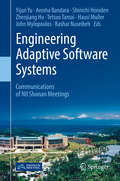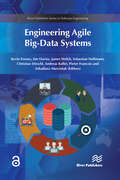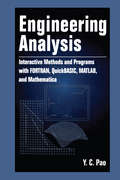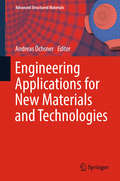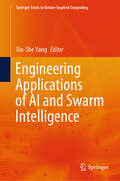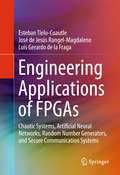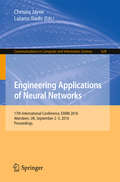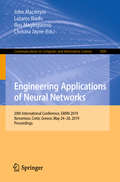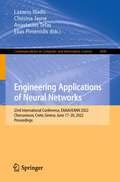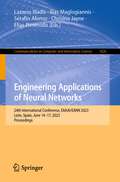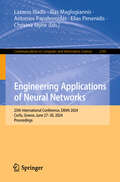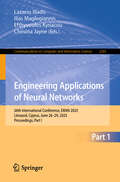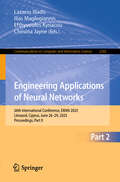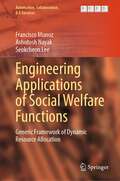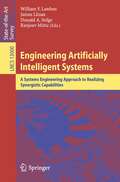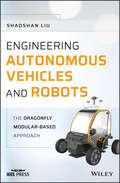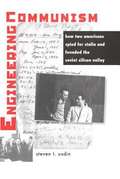- Table View
- List View
Engaging the Rewired Brain
by David A. SousaTechnology is not only affecting students’ brains—it is TRANSFORMING them! In a world where technology is increasingly dominant, it is critical to understand how it affects students′ brains and behavior—for better and for worse. This new edition from bestselling educational neuroscience author David Sousa offers research-based, practical solutions and serves as a framework for educators who want to effectively leverage technology to enhance student learning in an environment that demands constant engagement and stimulation. Inside you’ll discover The impact of technology on students′ brains, including how technology affects cognition, memory, attention, and behavior Strategies for using technology to improve students’ social and emotional skills New information on artificial intelligence, the after-effects of the pandemic, gaming, and productive struggle A glossary of terms and a resources section to connect educators with supplemental materials and information Students are engaging with technology in new ways every day, and educators must shift their instructional practices accordingly. Engaging the Rewired Brain is a must-read for today’s educators and parents striving to understand technology′s impact on the developing brain and prepare today′s learners for an increasingly complex future.
Engaging the Rewired Brain
by David A. SousaTechnology is not only affecting students’ brains—it is TRANSFORMING them! In a world where technology is increasingly dominant, it is critical to understand how it affects students′ brains and behavior—for better and for worse. This new edition from bestselling educational neuroscience author David Sousa offers research-based, practical solutions and serves as a framework for educators who want to effectively leverage technology to enhance student learning in an environment that demands constant engagement and stimulation. Inside you’ll discover The impact of technology on students′ brains, including how technology affects cognition, memory, attention, and behavior Strategies for using technology to improve students’ social and emotional skills New information on artificial intelligence, the after-effects of the pandemic, gaming, and productive struggle A glossary of terms and a resources section to connect educators with supplemental materials and information Students are engaging with technology in new ways every day, and educators must shift their instructional practices accordingly. Engaging the Rewired Brain is a must-read for today’s educators and parents striving to understand technology′s impact on the developing brain and prepare today′s learners for an increasingly complex future.
Engaños digitales, víctimas reales: Historias de estafas por internet y hackeos en la Argentina
by Sebastián DavidovskyA partir de nueve casos reales ocurridos en la Argentina, Sebastián Davidovsky, periodista especializado en tecnología, explica delitos como grooming, hackeo, phishing y ransomware. Cada caso sirve para conocer cómo operan los criminales, cómo funcionan las estafas y cómo estar prevenidos para evitarlas. Usamos mail, apps, WhatsApp, home banking, archivamos, compramos, subimos fotos. Y no percibimos que, del otro lado, alguien acecha todos nuestros datos y la intimidad. A partir de nueve casos argentinos, Sebastián Davidovsky explica cómo operan los criminales a través del grooming, phishing, ransomware y otros delitos a los que todos estamos expuestos. Dice María O'Donnell que "a los que nos acercamos a la tecnología con ingenuidad, pero agradecidos por las oportunidades que ofrece, este libro resulta tan ameno como inquietante. No abruma con datos ni pretende convertirnos al nerdismo, pero con hechos reales -que reconstruye con precisión- alerta sobre riesgos poco evidentes. Las historias iluminan sobre qué pasa cuando las cosas funcionan mal en una red a la que entregamos más información de lo prudente. Sebastián nos saca de la zona de comodidad, porque estamos acostumbrados a disfrutar de las soluciones, pero no nos ponemos a pensar en qué nos quitan". Para Tomás Balmaceda, "por su volumen e impacto, es posible que estos nuevos delitos estén a punto de tenernos como víctimas (si no es que ya nos pasó). Con olfato para las grandes historias, rigor investigativo y un ritmo que no descansa, en este libro hay casos de la Argentina que nos obligan a repensar nuestra conducta digital. Además de entretener y crear conciencia, Sebastián brinda consejos para evitar ser víctimas de estos nuevos criminales, que no usan máscaras ni llevan ganzúas, sino que se esconden detrás de un usuario y una pantalla".
Engineering Adaptive Software Systems: Communications Of NII Shonan Meetings (Lecture Notes In Computer Science / Programming And Software Engineering Ser. #7475)
by John Mylopoulos Yijun Yu Arosha Bandara Shinichi Honiden Zhenjiang Hu Tetsuo Tamai Hausi Muller Bashar NuseibehThis book discusses the problems and challenges in the interdisciplinary research field of self-adaptive software systems. Modern society is increasingly filled with software-intensive systems, which are required to operate in more and more dynamic and uncertain environments. These systems must monitor and control their environment while adapting to meet the requirements at runtime. This book provides promising approaches and research methods in software engineering, system engineering, and related fields to address the challenges in engineering the next-generation adaptive software systems. The contents of the book range from design and engineering principles (Chap. 1) to control–theoretic solutions (Chap. 2) and bidirectional transformations (Chap. 3), which can be seen as promising ways to implement the functional requirements of self-adaptive systems. Important quality requirements are also dealt with by these approaches: parallel adaptation for performance (Chap. 4), self-adaptive authorization infrastructure for security (Chap. 5), and self-adaptive risk assessment for self-protection (Chap. 6). Finally, Chap. 7 provides a concrete self-adaptive robotics operating system as a testbed for self-adaptive systems. The book grew out of a series of the Shonan Meetings on this ambitious topic held in 2012, 2013, and 2015. The authors were active participants in the meetings and have brought in interesting points of view. After several years of reflection, they now have been able to crystalize the ideas contained herein and collaboratively pave the way for solving some aspects of the research problems. As a result, the book stands as a milestone to initiate further progress in this promising interdisciplinary research field.
Engineering Agile Big-Data Systems (River Publishers Series In Software Engineering Ser.)
by James Welch Jim Davies Kevin FeeneyTo be effective, data-intensive systems require extensive ongoing customisation to reflect changing user requirements, organisational policies, and the structure and interpretation of the data they hold. Manual customisation is expensive, time-consuming, and error-prone. In large complex systems, the value of the data can be such that exhaustive testing is necessary before any new feature can be added to the existing design. In most cases, the precise details of requirements, policies and data will change during the lifetime of the system, forcing a choice between expensive modification and continued operation with an inefficient design.Engineering Agile Big-Data Systems outlines an approach to dealing with these problems in software and data engineering, describing a methodology for aligning these processes throughout product lifecycles. It discusses tools which can be used to achieve these goals, and, in a number of case studies, shows how the tools and methodology have been used to improve a variety of academic and business systems.
Engineering Analysis: Interactive Methods and Programs with FORTRAN, QuickBASIC, MATLAB, and Mathematica (Allyn And Bacon Series In Mechanical Engineering)
by Yen-Ching PaoThis book provides a concise introduction to numerical concepts in engineering analysis, using FORTRAN, QuickBASIC, MATLAB, and Mathematica to illustrate the examples. Discussions include:matrix algebra and analysissolution of matrix equationsmethods of curve fitmethods for finding the roots of polynom
Engineering Applications for New Materials and Technologies (Advanced Structured Materials #85)
by Andreas ÖchsnerThis book discusses the expertise, skills, and techniques needed for the development of new materials and technologies. It focuses on finite element and finite volume methods that are used for engineering simulations, and present many state-of-the-art applications and advances to highlight these methods’ importance. For example, modern joining technologies can be used to fabricate new compound or composite materials, even those formed from dissimilar component materials. These composite materials are often exposed to harsh environments, must deliver specific characteristics, and are primarily used in automotive and marine technologies, i.e., ships, amphibious vehicles, docks, offshore structures, and even robots. To achieve the desired material performance, computer-based engineering tools are widely used for simulation, data evaluation, and design processes.
Engineering Applications of AI and Swarm Intelligence (Springer Tracts in Nature-Inspired Computing)
by Xin-She YangThe book is focused on latest developments and findings on engineering applications of AI and swarm intelligence. It provides comprehensive reviews and surveys on implementations and coding aspects of case studies and applications where appropriate. The book is useful for scholars, lecturers, and practitioners from academia and industrial applications. The readership of this book also includes Ph.D. students and researchers with a wide experience in the subject areas.
Engineering Applications of Artificial Intelligence (Synthesis Lectures on Engineering, Science, and Technology)
by Rohit Bansal Aziza Chakir Johanes Fernandes Andry Arif Ullah Mohamed GhazouaniMaking intelligent devices and systems is the science and engineering of artificial intelligence (AI). In order to solve many of the most difficult problems in computer science, this important multidisciplinary discipline plays a crucial role in the field of technology nowadays. The book also addresses the topic of machine learning because it is closely related to AI. By no means is the list of subjects below intended to be comprehensive. The main objective of this book is to provide researchers, scientists, business professionals, and academics insight into original theories and research findings on the use of human cognitive models in diverse real-world computing applications. Through this book, the authors built an interdisciplinary forum where researchers from many fields may share their work and explore how to engineer human brain processes, learning mechanisms, and decision-making processes.
Engineering Applications of FPGAs
by Esteban Tlelo-Cuautle José de Jesús Rangel-Magdaleno Luis Gerardo De la FragaThis book offers readers a clear guide to implementing engineering applications with FPGAs, from the mathematical description to the hardware synthesis, including discussion of VHDL programming and co-simulation issues. Coverage includes FPGA realizations such as: chaos generators that are described from their mathematical models; artificial neural networks (ANNs) to predict chaotic time series, for which a discussion of different ANN topologies is included, with different learning techniques and activation functions; random number generators (RNGs) that are realized using different chaos generators, and discussions of their maximum Lyapunov exponent values and entropies. Finally, optimized chaotic oscillators are synchronized and realized to implement a secure communication system that processes black and white and grey-scale images. In each application, readers will find VHDL programming guidelines and computer arithmetic issues, along with co-simulation examples with Active-HDL and Simulink. The whole book provides a practical guide to implementing a variety of engineering applications from VHDL programming and co-simulation issues, to FPGA realizations of chaos generators, ANNs for chaotic time-series prediction, RNGs and chaotic secure communications for image transmission.
Engineering Applications of Modern Metaheuristics (Studies in Computational Intelligence #1069)
by A. Şima Etaner-Uyar Diego Oliva Ahmed M. Anter Taymaz AkanThis book is a collection of various methodologies that make it possible for metaheuristics and hyper-heuristics to solve problems that occur in the real world. This book contains chapters that make use of metaheuristics techniques. The application fields range from image processing to transmission power control, and case studies and literature reviews are included to assist the reader. Furthermore, some chapters present cutting-edge methods for load frequency control and IoT implementations. In this sense, the book offers both theoretical and practical contents in the form of metaheuristic algorithms. The researchers used several stochastic optimization methods in this book, including evolutionary algorithms and Swarm-based algorithms. The chapters were written from a scientific standpoint. As a result, the book is primarily aimed at undergraduate and postgraduate students of Science, Engineering, and Computational Mathematics, but it can also be used in courses on Artificial Intelligence, among other things. Similarly, the material may be beneficial to research in evolutionary computation and artificial intelligence communities.
Engineering Applications of Neural Networks
by Chrisina Jayne Lazaros Iliadis Giacomo Boracchi Aristidis LikasThis book constitutes the refereed proceedings of the 13th International Conference on Engineering Applications of Neural Networks, EANN 2012, held in London, UK, in September 2012. The 49 revised full papers presented were carefully reviewed and selected from numerous submissions. The papers describe the applications of neural networks and other computational intelligence approaches to intelligent transport, environmental engineering, computer security, civil engineering, financial forecasting, virtual learning environments, language interpretation, bioinformatics and general engineering.
Engineering Applications of Neural Networks
by Chrisina Jayne Lazaros IliadisThis book constitutes the refereed proceedings of the 13th International Conference on Engineering Applications of Neural Networks, EANN 2012, held in London, UK, in September 2012. The 49 revised full papers presented were carefully reviewed and selected from numerous submissions. The papers describe the applications of neural networks and other computational intelligence approaches to intelligent transport, environmental engineering, computer security, civil engineering, financial forecasting, virtual learning environments, language interpretation, bioinformatics and general engineering.
Engineering Applications of Neural Networks: 19th International Conference, EANN 2018, Bristol, UK, September 3-5, 2018, Proceedings (Communications in Computer and Information Science #893)
by Elias Pimenidis Chrisina JayneThis book constitutes the refereed proceedings of the 19th International Conference on Engineering Applications of Neural Networks, EANN 2018, held in Bristol, UK, in September 2018.The 16 revised full papers and 5 revised short papers presented were carefully reviewed and selected from 39 submissions. The papers are organized in topical sections on activity recognition, deep learning, extreme learning machine, machine learning applications, predictive models, fuzzy and recommender systems, recurrent neural networks, spiking neural networks.
Engineering Applications of Neural Networks: 20th International Conference, EANN 2019, Xersonisos, Crete, Greece, May 24-26, 2019, Proceedings (Communications in Computer and Information Science #1000)
by Chrisina Jayne Lazaros Iliadis Ilias Maglogiannis John MacintyreThis book constitutes the refereed proceedings of the 19th International Conference on Engineering Applications of Neural Networks, EANN 2019, held in Xersonisos, Crete, Greece, in May 2019.The 35 revised full papers and 5 revised short papers presented were carefully reviewed and selected from 72 submissions. The papers are organized in topical sections on AI in energy management - industrial applications; biomedical - bioinformatics modeling; classification - learning; deep learning; deep learning - convolutional ANN; fuzzy - vulnerability - navigation modeling; machine learning modeling - optimization; ML - DL financial modeling; security - anomaly detection; 1st PEINT workshop.
Engineering Applications of Neural Networks: 23rd International Conference, EAAAI/EANN 2022, Chersonissos, Crete, Greece, June 17–20, 2022, Proceedings (Communications in Computer and Information Science #1600)
by Elias Pimenidis Chrisina Jayne Lazaros Iliadis Anastasios TefasThis book constitutes the refereed proceedings of the 23rd International Conference on Engineering Applications of Neural Networks, EANN 2022, held in Chersonisos, Crete, Greece, in June 2022.The 37 revised full papers and 5 revised short papers presented were carefully reviewed and selected from 72 submissions. The papers are organized in topical sections on Bio inspired Modeling / Novel Neural Architectures; Classification / Clustering; Machine Learning; Convolutional / Deep Learning; Datamining / Learning / Autoencoders; Deep Learning / Blockchain; Machine Learning for Medical Images / Genome Classification; Reinforcement /Adversarial / Echo State Neural Networks; Robotics / Autonomous Vehicles, Photonic Neural Networks; Text Classification / Natural Language.
Engineering Applications of Neural Networks: 24th International Conference, EAAAI/EANN 2023, León, Spain, June 14–17, 2023, Proceedings (Communications in Computer and Information Science #1826)
by Elias Pimenidis Chrisina Jayne Lazaros Iliadis Ilias Maglogiannis Serafin AlonsoThis book constitutes the refereed proceedings of the 24th International Conference on Engineering Applications of Neural Networks, EANN 2023, held in León, Spain, in June 2023.The 41 revised full papers and 8 revised short papers presented were carefully reviewed and selected from 125 submissions. The papers are organized in topical sections on artificial intelligence - computational methods - ethology; classification - filtering - genetic algorithms; complex dynamic networks' optimization/ graph neural networks; convolutional neural networks/spiking neural networks; deep learning modeling; deep/machine learning in engineering; LEARNING (reinforcemet - federated - adversarial - transfer); natural language - recommendation systems.
Engineering Applications of Neural Networks: 25th International Conference, EANN 2024, Corfu, Greece, June 27–30, 2024, Proceedings (Communications in Computer and Information Science #2141)
by Elias Pimenidis Chrisina Jayne Lazaros Iliadis Ilias Maglogiannis Antonios PapaleonidasThis book constitutes the refereed proceedings of the 25th International Conference on Engineering Applications of Neural Networks, EANN 2024, held in Corfu, Greece, during June 27-30, 2024. The 41 full and 2 short papers included in this book were carefully reviewed and selected from 85 submissions. They deal with reinforcement; natural language; biomedical applications; classificaiton; deep learning; convolutional neural networks.
Engineering Applications of Neural Networks: 26th International Conference, EANN 2025, Limassol, Cyprus, June 26–29, 2025, Proceedings, Part I (Communications in Computer and Information Science #2581)
by Efthyvoulos Kyriacou Chrisina Jayne Lazaros Iliadis Ilias MaglogiannisThe two-volume set CCIS 2581 and 2582 constitutes the refereed proceedings of the 26th International Conference on Engineering Applications of Neural Networks, EANN 2025, held in Limassol, Cyprus during June 26–29, 2025. The 41 full papers included in these proceedings were carefully reviewed and selected from 101 submissions. These papers demonstrate the vitality of Artificial Intelligence algorithms and approaches, as well as AI applications.
Engineering Applications of Neural Networks: 26th International Conference, EANN 2025, Limassol, Cyprus, June 26–29, 2025, Proceedings, Part II (Communications in Computer and Information Science #2582)
by Efthyvoulos Kyriacou Chrisina Jayne Lazaros Iliadis Ilias MaglogiannisThe two-volume set CCIS 2581 and 2582 constitutes the refereed proceedings of the 26th International Conference on Engineering Applications of Neural Networks, EANN 2025, held in Limassol, Cyprus during June 26–29, 2025. The 41 full papers included in these proceedings were carefully reviewed and selected from 101 submissions. These papers demonstrate the vitality of Artificial Intelligence algorithms and approaches, as well as AI applications.
Engineering Applications of Noncommutative Harmonic Analysis: With Emphasis on Rotation and Motion Groups (Routledge Revivals)
by Gregory S. Chirikjian Alexander B. KyatkinFirst published in 2001. The classical Fourier transform is one of the most widely used mathematical tools in engineering. However, few engineers know that extensions of harmonic analysis to functions on groups holds great potential for solving problems in robotics, image analysis, mechanics, and other areas. For those that may be aware of its potential value, there is still no place they can turn to for a clear presentation of the background they need to apply the concept to engineering problems.Engineering Applications of Noncommutative Harmonic Analysis brings this powerful tool to the engineering world. Written specifically for engineers and computer scientists, it offers a practical treatment of harmonic analysis in the context of particular Lie groups (rotation and Euclidean motion). It presents only a limited number of proofs, focusing instead on providing a review of the fundamental mathematical results unknown to most engineers and detailed discussions of specific applications.Advances in pure mathematics can lead to very tangible advances in engineering, but only if they are available and accessible to engineers. Engineering Applications of Noncommutative Harmonic Analysis provides the means for adding this valuable and effective technique to the engineer's toolbox.
Engineering Applications of Social Welfare Functions: Generic Framework of Dynamic Resource Allocation (Automation, Collaboration, & E-Services #13)
by Francisco Munoz Ashutosh Nayak Seokcheon LeeThis book presents social welfare functions as a unified multidisciplinary framework for various resource allocation problems. By measuring the impact of local decisions on broader society, social welfare functions enable “socialized” decisions and thereby produce an emergent property that “global” balance and welfare emerge from “local” welfare-maximizing behaviors. Social welfare functions are originally used in economics to quantify income welfare, jointly considering average and inequality to arrive at better measures of welfare than average alone. Wishing the readers to find opportunities for their problems of interest, this book introduces research results of social welfare functions applied in five different engineering applications, defining welfare metrics pertaining to the characteristics of the application. The “energy welfare” in wireless sensor network measures richness of distributed sensors in energy. The “preparedness welfare” in emergency medical services quantifies the preparedness level of an entire service area by aggregating preparedness levels of individual zones. The “preference welfare” in intelligent shared environments represents the opinions of real people for groups. The “resource welfare” in multi-robot task allocation quantifies the efficiency of utilizing distributed resources across robots. The “utility welfare” in complex cyber-physical systems quantifies the impact of local resource sharing decisions on the broader task communities.
Engineering Artificially Intelligent Systems: A Systems Engineering Approach to Realizing Synergistic Capabilities (Lecture Notes in Computer Science #13000)
by Ranjeev Mittu James Llinas William F. Lawless Donald A. SofgeMany current AI and machine learning algorithms and data and information fusion processes attempt in software to estimate situations in our complex world of nested feedback loops. Such algorithms and processes must gracefully and efficiently adapt to technical challenges such as data quality induced by these loops, and interdependencies that vary in complexity, space, and time.To realize effective and efficient designs of computational systems, a Systems Engineering perspective may provide a framework for identifying the interrelationships and patterns of change between components rather than static snapshots. We must study cascading interdependencies through this perspective to understand their behavior and to successfully adopt complex system-of-systems in society. This book derives in part from the presentations given at the AAAI 2021 Spring Symposium session on Leveraging Systems Engineering to Realize Synergistic AI / Machine Learning Capabilities. Its 16 chapters offer an emphasis on pragmatic aspects and address topics in systems engineering; AI, machine learning, and reasoning; data and information fusion; intelligent systems; autonomous systems; interdependence and teamwork; human-computer interaction; trust; and resilience.
Engineering Autonomous Vehicles and Robots: The DragonFly Modular-based Approach (Wiley - IEEE)
by Shaoshan LiuOffers a step-by-step guide to building autonomous vehicles and robots, with source code and accompanying videos The first book of its kind on the detailed steps for creating an autonomous vehicle or robot, this book provides an overview of the technology and introduction of the key elements involved in developing autonomous vehicles, and offers an excellent introduction to the basics for someone new to the topic of autonomous vehicles and the innovative, modular-based engineering approach called DragonFly. Engineering Autonomous Vehicles and Robots: The DragonFly Modular-based Approach covers everything that technical professionals need to know about: CAN bus, chassis, sonars, radars, GNSS, computer vision, localization, perception, motion planning, and more. Particularly, it covers Computer Vision for active perception and localization, as well as mapping and motion planning. The book offers several case studies on the building of an autonomous passenger pod, bus, and vending robot. It features a large amount of supplementary material, including the standard protocol and sample codes for chassis, sonar, and radar. GPSD protocol/NMEA protocol and GPS deployment methods are also provided. Most importantly, readers will learn the philosophy behind the DragonFly modular-based design approach, which empowers readers to design and build their own autonomous vehicles and robots with flexibility and affordability. Offers progressive guidance on building autonomous vehicles and robots Provides detailed steps and codes to create an autonomous machine, at affordable cost, and with a modular approach Written by one of the pioneers in the field building autonomous vehicles Includes case studies, source code, and state-of-the art research results Accompanied by a website with supplementary material, including sample code for chassis/sonar/radar; GPS deployment methods; Vision Calibration methods Engineering Autonomous Vehicles and Robots is an excellent book for students, researchers, and practitioners in the field of autonomous vehicles and robots.
Engineering Communism: How Two Americans Spied for Stalin and Founded the Soviet Silicon Valley
by Steven T. UsdinEngineering Communism is the fascinating story of Joel Barr and Alfred Sarant, dedicated Communists and members of the Rosenberg spy ring, who stole information from the United States during World War II that proved crucial to building the first advanced weapons systems in the USSR. On the brink of arrest, they escaped with KGB's help and eluded American intelligence for decades. Drawing on extensive interviews with Barr and new archival evidence, Steve Usdin explains why Barr and Sarant became spies, how they obtained military secrets, and how FBI blunders led to their escape. He chronicles their pioneering role in the Soviet computer industry, including their success in convincing Nikita Khrushchev to build a secret Silicon Valley. The book is rich with details of Barr's and Sarant's intriguing and exciting personal lives, their families, as well as their integration into Russian society. Engineering Communism follows the two spies through Sarant's death and Barr's unbelievable return to the United States.


